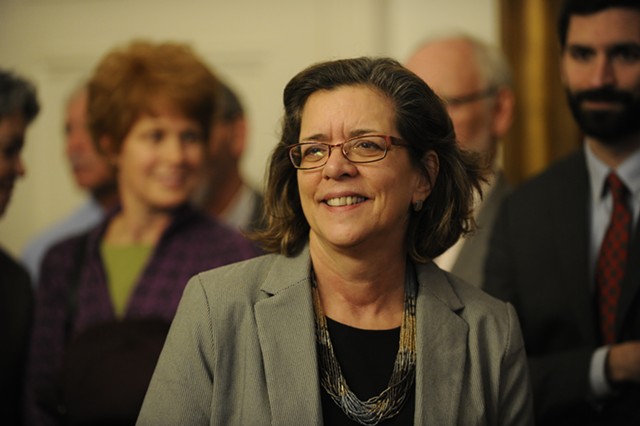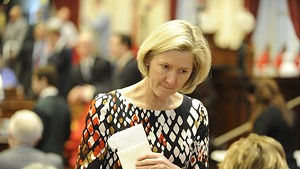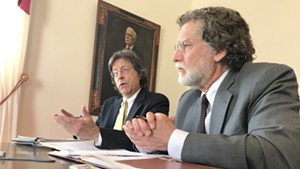
- File: Jeb Wallace-Brodeur
- Secretary of Administration Susanne Young
When Vermont lawmakers signed off on a short-term state budget in June, they were prepared to return in August to an even bigger fiscal mess, created by the devastating toll the coronavirus pandemic has taken on the state’s economy. But for now, at least, the mess isn’t as big as expected — thanks to unanticipated tax revenue, state government savings and federal assistance.
As a result, Gov. Phil Scott’s administration believes the state can survive the current fiscal year without raising taxes, cutting programs or depleting its reserves.
“Just like families are doing, we’re setting priorities — trying to do things smarter and better while making some difficult decisions,” Scott said at a press conference on Tuesday. “The bottom line is we’re not spending more than we’re taking in, and we’re living within our means.”
In a proposal submitted to the legislature later Tuesday, the Scott administration pitched a nearly $1.7 billion general fund budget for the 2021 fiscal year that, in some ways, mirrors the plan he laid out in January, before the pandemic reached Vermont.
"This budget represents a calm hand on the tiller, steering through turbulent water," Scott's finance commissioner, Adam Greshin, told reporters. "This is not the time for major changes."
A new forecast last week from Vermont's state economists projected that the general fund would collect $182 million less in tax revenue this year than anticipated in January. That represents a downgrade of more than 11 percent, but it's less dire than the economists expected just months ago.
The state also benefited from a nearly $130 million surplus, which helped to bridge the gap. That was the result of greater-than-expected 2019 tax receipts, which arrived belatedly in July, as well as savings ordered up in the spring at the height of the pandemic. Departments and agencies managed to cut another $28 million in costs, in part by limiting travel and delaying the hiring of seasonal workers during the outbreak.
Federal assistance also made a difference, because state government workers participating in the response to the pandemic can be paid with emergency relief dollars and because the feds have boosted Medicaid payments to the state during the emergency.
The Scott administration not only avoided making draconian cuts, it proposed $14 million in additional general fund spending, including covering $6 million in costs typically borne by the transportation fund, such as paving and mowing. It also proposed spending $2 million on payments to those who missed out on federal stimulus payments, such as undocumented workers.
"I think this budget represents the wind at our back," Secretary of Administration Susanne Young told reporters.
Before adjourning in June, the legislature signed off on a first-quarter budget that set state spending levels from July through September of this year. The budget "restatement" the administration presented to lawmakers on Tuesday would guide spending for the remaining three quarters of the fiscal year and make minor changes to the first-quarter plan, as well.
The full legislature, which is scheduled to reconvene next week, has until late September to consider the administration’s budget proposal, revise it and send it back to the governor for his signature.
Lawmakers must also determine how to dole out the remainder of the $1.25 billion in CARES Act funds the federal government provided to Vermont. Under current guidance from the U.S. Department of the Treasury, the money must be spent by the end of this calendar year — and it cannot cover costs previously approved by state and local governments.
Among the reasons Scott and the legislature held off on completing this year's budget was an expectation that Congress and President Donald Trump would agree to another round of federal aid, which might increase the amount of money the state had to spend and provide more flexibility to spend what it has already received.
"Regrettably, they did not," Young said. "So, disappointingly, we are now back where we started, with no additional flexibility in the funding arena ... and really nothing has changed since the legislature adjourned."
In addition to its budget proposal, the administration also provided the legislature on Tuesday with several wish lists that might guide the use of available CARES Act money. It called on the legislature to appropriate $152 million to cover pandemic-related expenses across state government and to provide additional grants to struggling businesses and nonprofits.
It asked the legislature's Joint Fiscal Committee to approve another $47 million worth of expenses, including a $20 million state match to extend unemployment insurance payments and $12 million for remote learning and childcare programs.
The administration also came up with a $44 million list of initiatives it would fund if the federal government provided additional flexibility, including $30 million for the Vermont State Colleges System.
Young and Greshin warned that, while the state might not have to make tough decisions this fiscal year, it would almost certainly have to next year. According to Young, it will be a "slow climb over a couple fiscal years" before the state budget fully recovers.
















Comments
Comments are closed.
From 2014-2020, Seven Days allowed readers to comment on all stories posted on our website. While we've appreciated the suggestions and insights, right now Seven Days is prioritizing our core mission — producing high-quality, responsible local journalism — over moderating online debates between readers.
To criticize, correct or praise our reporting, please send us a letter to the editor or send us a tip. We’ll check it out and report the results.
Online comments may return when we have better tech tools for managing them. Thanks for reading.